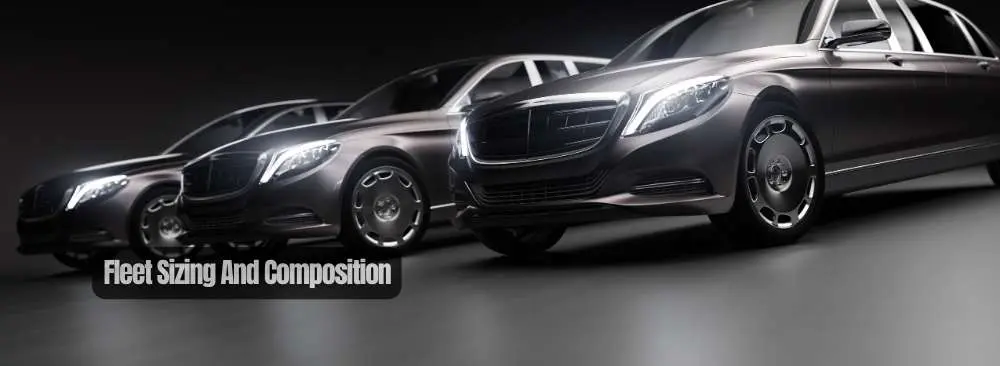As businesses grow, so does their need for efficient and effective transportation. Fleet sizing and composition are crucial for any company that relies on transportation, as they directly impact the operation’s cost, safety, and reliability.

We will delve into the optimal strategies for determining fleet size and composition. This knowledge will empower you to enhance your business’s transportation efficiency, paving the way for enduring success.
Fleet Sizing and Composition
Now that you grasp the available vehicle types, delve into fleet sizing and composition, which are pivotal considerations. Optimizing these factors will align your fleet with operational demands, ensuring efficiency and cost-effectiveness. These decisions will directly impact your business’s efficiency and cost-effectiveness.
Determining the optimal fleet size
The size of your fleet should align with your operational needs while being mindful of your budget constraints. Here’s how to determine the right fleet size:
Demand Analysis
- Example: If you’re running a taxi service in Munich, analyze historical and projected demand to determine how many vehicles you need to meet peak-hour requirements.
Utilization Rate
- Example: A courier company in Frankfurt may assess how many deliveries each vehicle can handle and then calculate the total number of cars required based on daily delivery volume.
Seasonal Variations
- Example: If you operate a tourist shuttle service in Berlin, consider seasonal fluctuations in demand and adjust your fleet size accordingly.
Scalability
- Example: Startups in Hamburg might begin with a small fleet and gradually expand as the business grows to ensure they can meet the increasing demand.
Balancing vehicle types in your fleet
Maintaining a balanced composition of vehicles ensures versatility and efficiency. Here’s how to strike the right balance:
Diversification
- Example: A logistics company operating in multiple cities across Germany might have a mix of vans for local deliveries and long-haul trucks for intercity transport.
Fleet Specialization
- Example: A florist in Munich may have smaller vehicles for delicate floral arrangements and larger vans for bulk deliveries to event venues.
Reserve Vehicles
- Example: Consider having a few reserve vehicles to accommodate unexpected surges in demand or to replace vehicles undergoing maintenance.
The role of electric and hybrid vehicles
Align with the EU’s environmental initiatives and Germany’s sustainability drive by considering electric and hybrid vehicles for your fleet. Their adoption promotes eco-friendliness while potentially reducing operational costs over time.
Cost Savings
- Example: Electric vehicles (EVs) may have higher upfront costs but lower operating costs due to reduced fuel and maintenance expenses.
Emissions Reduction
- Example: In cities with strict emissions regulations like Stuttgart, electric or hybrid vehicles can help your business avoid fines and penalties.
Government Incentives
- Example: Germany offers subsidies and tax incentives for businesses that adopt electric vehicles, making them an attractive option for fleet managers.
Customer Appeal
- Example: In Berlin, where eco-conscious consumers are prevalent, using electric or hybrid vehicles in your fleet can enhance your brand’s image and attract environmentally aware customers.
When determining the role of electric and hybrid vehicles in your fleet, consider factors such as charging infrastructure, range, and the availability of suitable models that meet your operational requirements.
Meticulous assessment lays the groundwork for an efficient car fleet that supports your business objectives. Thorough fleet size and composition planning ensure alignment between your operational needs and the vehicles at your disposal. Including eco-friendly vehicles further enhances sustainability, positioning you favorably in the face of environmental initiatives.
Conclusion: Fleet Sizing And Composition
In conclusion, fleet sizing and composition play a significant role in the success of any business that relies on transportation. Analyzing demand, utilization rates, seasonal variations, and scalability empowers companies to determine the optimal fleet size. This data-driven approach optimizes transportation operations, avoiding excess capacity or resource constraints.
Maintaining a balanced fleet composition is essential for businesses. Additionally, incorporating electric and hybrid vehicles can reduce costs and emissions while enhancing the company’s brand image as an environmentally conscious organization.
With careful planning and consideration of these factors, companies can create an efficient, sustainable, and cost-effective car fleet that aligns with their goals and ensures long-term success.
Fleet Related Topics:
How To Manage Your Fleet Budget Effectively And Save Money
Fleet Acquisition Options: Buying New Vs. Used Vehicles Or Leasing
Fleet Operations: 10 Easy Ways To Reduce The Operating Costs
